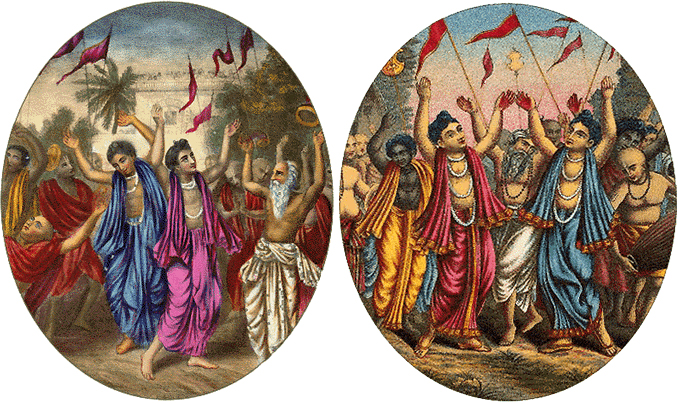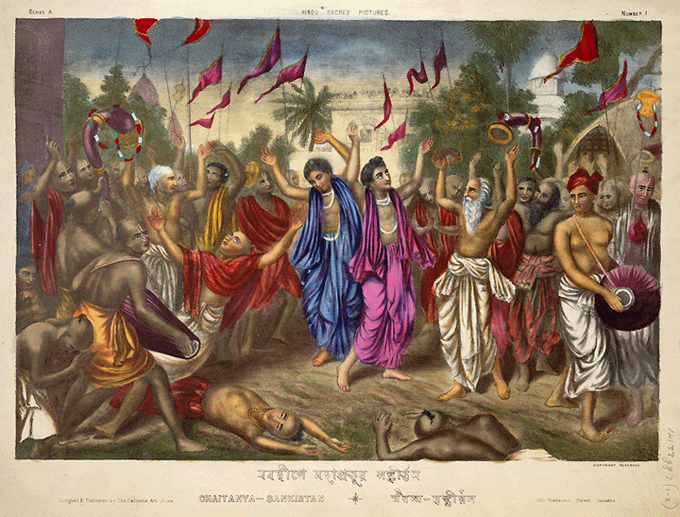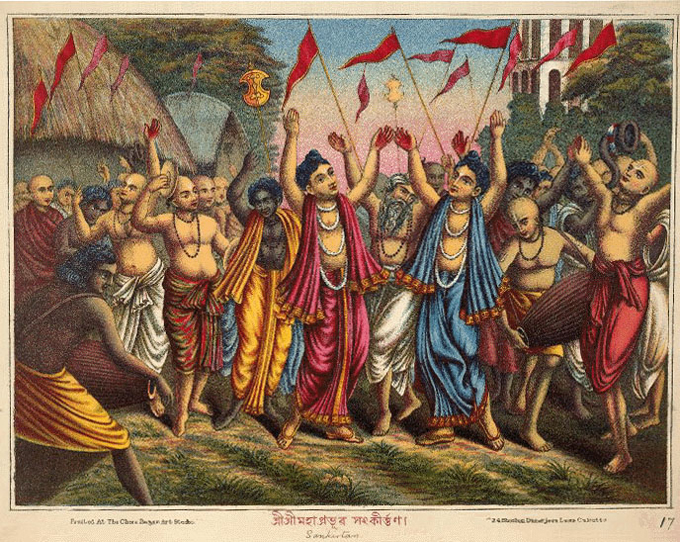
|
|
|
|
BY: SUN STAFF

Lord Caitanya's Sankirtan Apr 15, 2011 — CANADA (SUN) — A study of the historical, spiritual and cultural elements of Vedic design. Today we'll make a brief comparative study of the two Calcutta lithographs depicting Lord Caitanya Mahaprabhu's Sankirtana party. There are a number of interesting similarities and differences in design motif employed by the two artists. The Calcutta Art Studio (CAS) was founded in 1878 by Ananda Prasad Bagchi and several other artists, while the Chore Bagan press was founded by a group of artists in 1890. Some sources list the Calcutta Art Studio's Sankirtan print at circa 1880 while others, including the British Museum, give the same date for both prints, circa 1895. Although we cannot be sure which print came first, the former clearly influenced the subsequent version. While there is a high degree of duplication in the composition of these Sankirtan scenes, there are also some unique elements in each one. In some ways, the Chore Bagan print has a more traditional appeal, and the CAS a more modern mood. This is primarily due to the coloration, with the CAS litho employing a bright purplish shade for Mahaprabhu's clothing, the flags and instruments. These elements are a more common reddish shade in the Chore Bagan print. The CAS print uses a similar reddish color as their main secondary shade, while Chore Bagan balanced with gold tones. Nityananda Prabhu is dressed in His traditional blue garb, but the artists have Lord Caitanya in less traditional red or purple colors, rather than the golden cloth one might expect, as we saw in a previous segment on the Pancha Tattva lithos. Of course, we see Mahaprabhu is not yet shaven here, so the artists may simply have been avoiding shades reminiscent of sannyasa cloth.

Lord Caitanya's Sankirtana Party 
Lord Caitanya's Sankirtana Party One interesting point of comparison is the fact that both artists used an unusual mottled red and greenish-gold on one of the devotee's dhoti. This is significant from a design viewpoint because the mottled colors are not a traditional motif, thus making an all the more obvious point of reproduction by the latter artist. There are interesting architectural backgrounds in the two prints, combining thatched huts with more permanent stone buildings, and the CAS print includes two temple domes in addition. In both cases, we get a sense of the Sankirtan party moving through towns and villages. Considering the placement of figures, we see that Gaura and Nitai are in reversed order in the two prints. Advaita Prabhu is prominently in front in the CAS print, but he's presented in an equally nice fashion in the Chore Bagan, framed between the upraised arms of Gauranga and Nityananda. Studying all the faces, there is a decidedly more Western flavor in the features of devotees in the CAS lithograph, while the Chore Bagan artist use more contrast in skin tone to suggest different castes or ethnicities. In the CAS print, quite a few more devotees are seen wearing tilak. While no women are pictured in the Chore Bagan Sankirtan party, we see that the Calcutta Art Studio print has included two. They are subtly placed along the left side, one with head covered in blue sari, the other kneeling in the forefront. A major difference in composition is the two devotees fallen to the ground in a faint from the ecstasies of chanting the Holy Names, in the CAS lithograph. We are fortunate that these remarkably beautiful examples of Vaisnava art are still available to be enjoyed nearly 120 years after they were printed. The devotees can still get absorbed in the mood of Caitanya Mahaprabhu's glorious Sankirtan movement, as seen through the eyes of the artists of Calcutta.
| |